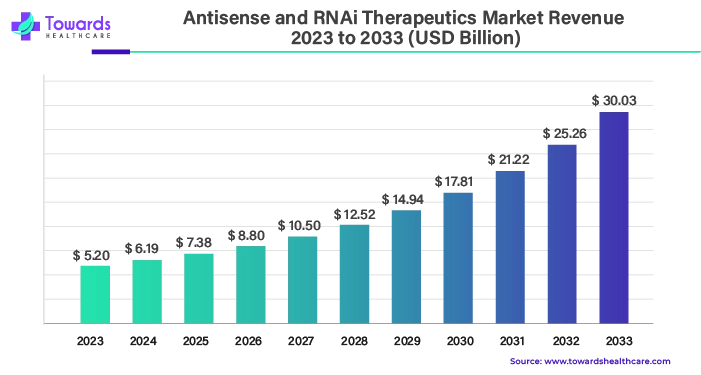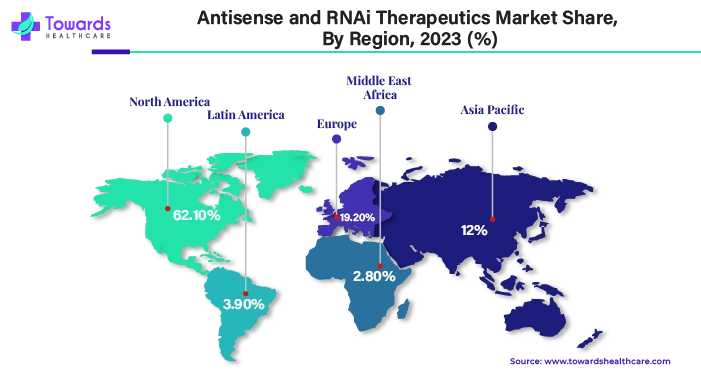April 2025

The global antisense and RNAi therapeutics market was estimated at US$ 5.20 billion in 2023 and is projected to grow to US$ 30.03 billion by 2033, rising at a compound annual growth rate (CAGR) of 19.12% from 2024 to 2033. Funding for research and development of rare diseases is promoting the market’s growth.

RNA therapeutics is the term for the application of oligonucleotides to target ribonucleic acids (RNA) primarily for therapeutic purposes or in investigations to clarify gene functions. The antisense and RNAi therapeutics market is supported by our expanding knowledge of RNA activities and their critical roles in disease. A number of RNA-based drugs are presently undergoing preclinical testing or inquiry before being licensed for clinical usage. Despite the enormous obstacles in producing therapies based on RNA, a variety of approaches have been investigated to improve RNA intracellular trafficking and metabolic stability.
From 2025 to 2030, the global antisense and RNAi therapeutics market is expected to see around US$ 7.38 billion in 2025 to reach about US$ 17.81 billion by 2030, with a strong annual growth rate of 19.12%. This surge is largely driven by increased investment in research for rare diseases, highlighting the growing demand for advanced genetic therapies.
Large volumes of information on disease-associated RNAs and small molecules that bind to these RNAs have already been gathered as a result of the strategy's recent surge in popularity. By increasing the effectiveness and caliber of decision-making, artificial intelligence (AI) techniques such as machine learning and deep learning offer a chance to expedite the identification of RNA-targeted small molecules.
For instance,
| Company Name | Deep Genomics |
| Headquarters | Toronto, Canada, North America |
| Recent Development | In June 2024, In addition to expanding its Toronto office and hiring many new leaders, Deep Genomics, a tech firm located in Toronto and launched in 2014, opened a new lab and office in Cambridge, Massachusetts. The firm seeks to use machine learning to create RNA therapeutics for hereditary illnesses. It employs over 100 people with backgrounds in AI, automation, molecular biology, clinical development, and software engineering. |
| Company Name | Exsilio Therapeutics |
| Headquarters | Boston, New England, Europe |
| Recent Development | In June 2024, Novartis Venture Fund and Delos Capital led a $82 million series A funding round for the launch of Exsilio Therapeutics. According to Exsilio, it will expand on mobile genetic elements—genetic material that can move anywhere within the genome—by integrating entire genes into "safe harbors" in the genome using lipid nanoparticles and messenger RNA (mRNA). |
The emergence of disease-modifying medications has given rise to new hopes as several nucleic acid (NA)-based therapies are now moving into the clinical stage. The era of NA-based therapies has completely changed the landscape of RD treatment. Genetic abnormalities and malignancies are among the many diseases for which RNA-based therapies have been extensively used.
For instance,
Notwithstanding their benefits, stability, and delivery remain critical factors in the future growth of therapeutic modalities. Because RNase in the cells or tissues can quickly break down RNA molecules due to their inherent instability, RNA molecules must be transported to the cytoplasm of the cell in order for them to govern biological activities within the cell. It is challenging for them to pass through the hydrophobic cytoplasmic membrane, though, because they are negative charges.
The recent invention of various RNA-based medications demonstrates the enormous promise of this topic. It is anticipated that novel RNA-based medications may surface to treat a range of illnesses for which there is now no known cure, based on the knowledge that has been gathered thus far. Drugs based on RNA have the ability to modify targets that were previously undruggable. Rapid medication design by researchers is another benefit of RNA treatment.
The antisense RNA segment held the largest share of the antisense and RNAi therapeutics market in 2023. One way to mute genes and prevent their expression is through antisense RNA (asRNA) technology. Replication, transcription, and translation are only a few of the stages at which antisense RNAs control the expression of genes. Furthermore, host cells' expression of linked genes can be efficiently controlled by synthetic antisense RNAs. As antisense RNA has evolved, a popular area of study has been centered on figuring out what roles these molecules play.
For instance,
The RNA interference segment is anticipated to grow at the fastest rate in the antisense and RNAi therapeutics market during the forecast period. When it comes to treating a variety of pathologic disorders like cancer, viral infections, and cardiovascular diseases, RNA interference (RNAi) is thought to be a very selective method of gene silencing. The research of RNA interference has advanced quickly, moving from an experimental technique to a potent tool for developing new therapeutics.
The neurodegenerative disorders segment dominated the antisense and RNAi therapeutics market in 2023. The majority of neurodegenerative diseases affect the elderly population and are frequently fatal. Thus, one of the main areas of interest for biomedical research is therapeutic development. The potential to target more disease-associated genes through a range of diverse mechanisms grows with the number of RNA-based techniques.
For instance,
The genetic disorders segment is expected to grow with the fastest CAGR in the antisense and RNAi therapeutics market during the forecast period. Two amazing and intriguing developments in the field of modern biomedicine are RNA vaccines and RNA therapeutic applications. Treating genetic illnesses with gene therapy using the novel RNA editing method appears promising. Through RNA correction of the illness-causing mutation, UC San Diego researchers demonstrated in a proof of concept that the method can treat a mouse model of Hurler syndrome, a rare genetic disorder.
For instance,
The intrathecal injections segment held the largest share of the antisense and RNAi therapeutics market in 2023. When using intrathecal drug delivery instead of oral or parenteral administration, far smaller quantities of medication are required to induce effective analgesia and decrease spasticity. Despite being an invasive process, intrathecal drug delivery system implantation has a low likelihood of complications. Intracerecal medication delivery has been extensively shown to be safe and effective in managing spasticity as well as pain associated with cancer and non-cancer conditions.
The subcutaneous injection segment is estimated to grow at the fastest rate in the antisense and RNAi therapeutics market during 2024-2033. Subcutaneous delivery carries fewer risks and is more convenient for patients when compared to intravenous (IV) administration. Additionally, because it is so simple to use, fewer medical personnel are required, which lowers healthcare costs. By avoiding first-pass extraction, which reduces interindividual variability and increases the amount of the medication available in the systemic circulation, oral administration also has an additional benefit.

North America dominated the antisense and RNAi therapeutics market by 62.10% in 2023. The accessibility of cutting-edge antisense and RNAi treatments is one factor driving the market's expansion in the area. Additionally, the region's well-established healthcare infrastructure contributes to a rise in early rare illness screening, which in turn raises the demand for RNAi and antisense therapies. For example, Cure SMA is a nonprofit organization whose goal is to advance and fund spinal muscular atrophy research.
Furthermore, an environment that is favorable for research and the advanced development needed to advance antisense and RNAi therapy platforms has been established thanks to the extraordinary assistance of numerous national governments and other global health organizations. The existence of numerous top biotech and pharmaceutical businesses in the area has hastened development prospects and product launches, according to the antisense & RNAi therapies market analysis. This has fostered tough rivalry and promoted innovation. The market for RNA-based medicines is further supported by the proactive regulatory climate in North America and the extraordinary involvement of the FDA, which has accelerated the development of numerous RNA-based medications for a variety of hereditary and chronic illness disorders. Furthermore, there is a need for antisense and RNAi therapies due to the high prevalence of target diseases, such as cancer and genetic abnormalities, in the area.
For instance,
Asia Pacific is expected to grow at the fastest rate during the forecast period. The main reason for the Asia Pacific antisense and RNAi therapeutics market's growth is that nations like China, Japan, and India are fostering domestic innovation and rapidly advancing their capacities for producing generic medications. A number of domestic biotech businesses are researching therapeutic treatments through RNA interference (RNAi) technologies. The comparatively reduced production costs in comparison to Western markets enable these players to concentrate on offering medications at reasonable prices. Owing to this benefit, multinational pharmaceutical companies are making major financial investments to increase their market share in various locations.
By Technology
By Application
By Route of Administration
By Region
Antibodies have become essential tools in life science research due to their precision in labeling and detection. In diagnostic medicine, these molecular markers enhance the accuracy of identifying specific antigens, allowing researchers to pinpoint the presence and concentration of particular proteins, which aids in diagnosing various diseases. Their high selectivity and specificity make them invaluable across biomedical research, including medicine, diagnostics, oncology, gene therapy, stem cell analysis, autoimmune disease therapy, and more.
The global research antibodies market size valued at approximately US$ 1.60 billion in 2023, is anticipated to reach US$ 2.55 billion by 2033. This growth represents a compound annual growth rate (CAGR) of 4.90% from 2024 to 2033. The increasing demand for high-quality antibodies to ensure reproducible research results is a key driver behind this market expansion.
April 2025
April 2025
April 2025
April 2025